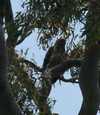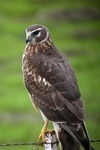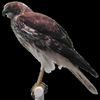Genus Circus
Western Marsh Harrier - Formerly, a number of relatives were included in C. aeruginosus, which was then known as "Marsh Harrier". The related taxa are now generally considered to be separate species: the Eastern Marsh-harrier and the possibly distinct Papuan Harrier spilothorax) of eastern Asia and the Wallacea, the Swamp Harrier of Australasia and the Madagascar Marsh-harrier of the western Indian Ocean islands.
Pacific Marsh Harrier - The Swamp Harrier is largely dark brown, becoming lighter with age, and has a distinct white rump. It hunts by flying slowly, low to the ground, on upswept wings. The body length is 50 to 60 cm , and the wingspan is 120 to 145 cm. The recorded weights of adults range from 580 to 1100 g, and females are significantly larger than the males.
Spotted Harrier - It is similar to the Swamp Harrier, distinguished by grey upperparts, chestnut facial disc and dark rump. Its wing length ranges between 375 and 470 mm, with females being larger.
Long-winged Harrier - It is found in Argentina, Bolivia, Brazil, Chile, Colombia, Falkland Islands, French Guiana, Guyana, Paraguay, Suriname, Trinidad and Tobago, Uruguay, and Venezuela.
Cinereous Harrier - The term cinereous describes its colouration. The male's plumage is dark grey above with black wingtips and a white rump. The underparts are pale grey, with a rufous streaked belly. The female's plumage is brown above, with a white rump, and cream coloured underneath, with a streaked belly similar to the males. The female is larger than the male with an average size of 50 centimetres compared to the male's 40 centimetres.
Hen Harrier - The Hen Harrier or Northern Harrier is a bird of prey. It breeds throughout the northern parts of the northern hemisphere in Canada and the northernmost USA, and in northern Eurasia. This species is polytypic, with two subspecies. Marsh Hawk is a colloquial name for the American form.
Madagascar Marsh-Harrier - The Malagasy Harrier is a bird of prey belonging to the marsh harrier group of harriers. It inhabits Madagascar and the Comoro Islands in the Indian Ocean. It was formerly regarded as a subspecies of the Réunion Harrier but is increasingly treated as a separate species. It is also known as the Madagascar Harrier, Madagascar Marsh Harrier or Malagasy Marsh Harrier.
Pallid Harrier - This medium-sized raptor breeds on open plains, bogs and heathland. In winter it is a bird of open country.
Reunion Harrier - It is about 50 cm long; the female is around 3–15% larger than the male. The male has a blackish head and back with white streaks. The underparts, underwings and rump are white and the tail is grey. The wings are grey and black with a white leading edge. Females and immatures are dark brown with a white rump and barred tail.
Black Harrier - When perched, this bird appears all black. However, in flight a white rump and flight feathers become visible. Its morphology is comparable to that of other harriers, with a slim body, narrow wings and a long tail. Male and female plumages are similar. Immatures have buff under-parts and a heavily spotted breast.
Pied Harrier - This medium-sized harrier nests in steppes and associated wetlands. Wintering individuals are often seen hunting above rice paddies and marshes.
Montagu's Harrier - Sexual dimorphism is particularly apparent in the plumage of this species. Adult males are characterized by their overall pale grey plumage contrasting with black wingtips. Compared with other harriers this species has characteristic black bands along the secondaries, both above and below the wing and rusty streaks on belly and flanks. Adult females have a broadly similar plumage to that of Pallid and Hen Harriers. The underparts are mostly pale yellow-brown, the belly with longitudinal stripes and the wing coverts spotted. The upper parts are uniform dark brown except for the white upper tail coverts , and the sightly paler central wing coverts.
African Marsh Harrier - The adult is 45 to 50 cm long and is mostly brown with pale streaking on the head, breast and forewing and rufous on the thighs and belly. Males and females are similar, unlike most harriers. The juvenile is dark brown with a pale breastband and pale markings on the head. The tail and flight feathers have dark barring at all ages. It is usually silent but has a high-pitched, two-note display call.
Eastern Marsh Harrier - It is 48 to 58 cm long with a wingspan of 113 to 137 cm; like most birds of prey, the female is usually larger than the male. The male's plumage is variable; typically the head, breast, back and wing-coverts are blackish with pale streaks. The rest of the wing is grey with black wingtips and a white front edge. The tail is grey, the rump is white and the underparts are mostly white. The female is dark brown with buff streaking on the head and underparts. The rump is often whitish and the tail has dark bars. Young birds are dark brown with buff on the head and a pale patch on the underwing.









